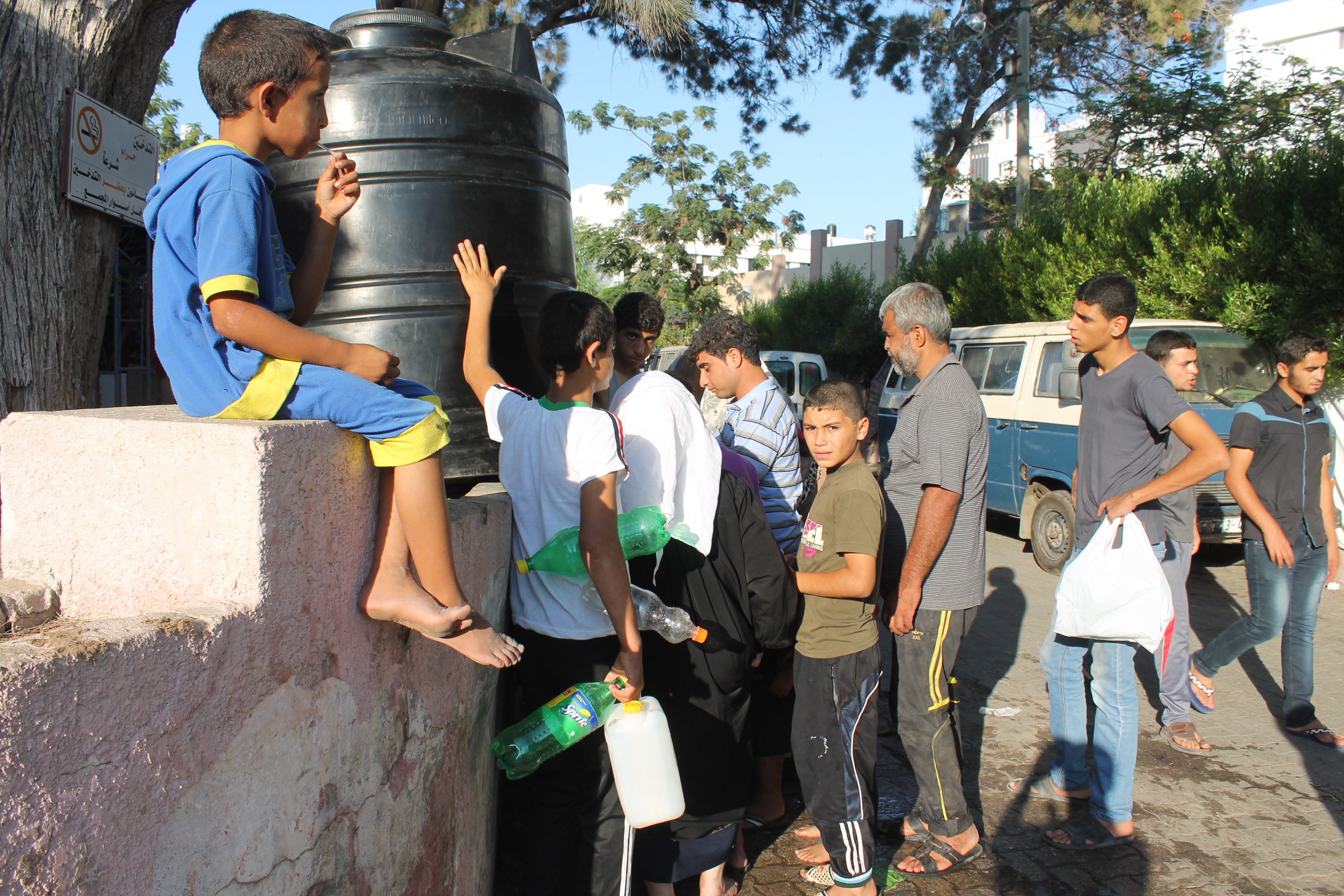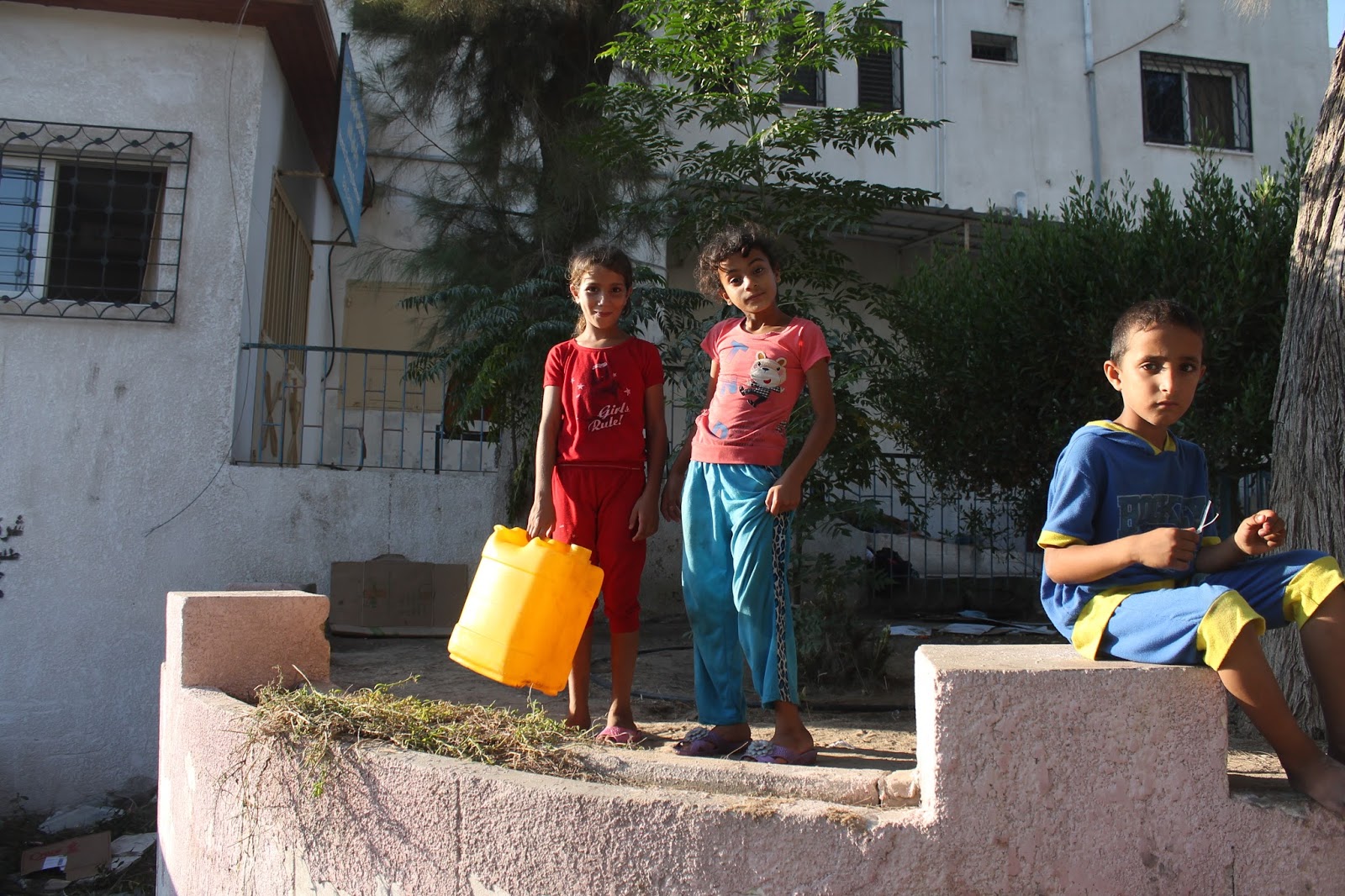Israel Escalates ‘Water-Apartheid’ As Illegal Settlers Contaminate Palestinian Water
by Joe Catron, September 29, 2015, MintPress News. Israel’s discriminatory allocation of water, along with its theft,
destruction and pollution of Palestinian water resources, sparks
accusations of racism and apartheid.

UNITED NATIONS — Israeli restrictions on Palestinian water
use, as well as damage to water supplies and infrastructure by both
Israeli forces and Jewish settlers, continue to deplete the already
limited water supplies available to millions of Palestinians in the
occupied West Bank and Gaza Strip.
“Water is used by the Israelis to achieve non-water interests, as a
tool of punishment,” Dr. Abed Elrahman Tamimi, director of the
Palestinian Hydrology Group in Ramallah, told MintPress News.
Meanwhile tens of thousands of Palestinians within Israel continue to
lack access to running water, despite their citizenship in the state
and the equality they should receive under its laws.
Israel has limited the water available to Palestinians in the Gaza
Strip and West Bank since its forces occupied the enclaves, placing them
under military rule, in 1967.
‘Scandalously uneven, humiliating and infuriating’
The Oslo II Accord, signed by Israel and Palestine Liberation
Organization on Sept. 28, 1995, formalized this disparity, imposing what
Israeli newspaper Haaretz writer Amira Hass called “a scandalously uneven, humiliating and infuriating division of the water resources of the West Bank.”
The agreement afforded Palestinians 118 million cubic meters of water
per year from the Mountain Aquifer that stretches into Israel from the
West Bank, while obligating Israel to sell Palestinians a further 27.9
mcm annually at full price.
It also entitled Israel to claim 483 mcm per year – over four times
as much – but allocated none to the Gaza Strip, which was left to rely
on the small Coastal Aquifer.
According to its own terms, Oslo II should have terminated in
Palestinian independence after five years, with a joint committee
increasing Palestine’s water allocation through consensus in the
meantime. Neither scenario has come to pass.
In coming years, Israel would make clear that it had no intention of
ever ending its control of Palestinian water. A June 7, 1997 order reiterated its longstanding policy: “All the water in the land that was occupied again is the property of the State of Israel.”
Successive governments pushed new waves of settlement construction,
universally considered war crimes under the fourth Geneva Convention, on
Palestinian lands in the West Bank. By 2000, the number of settlers had
swelled 26 percent.
Like earlier settlements, the sites of many new units were calculated
to maximize Israeli control of Palestinian water. In 2001, then-Israeli Prime Minister Ariel Sharon told Haaretz:
“Is it possible today to concede control of the aquifer, which supplies
a third of our water? Is it possible to cede the buffer zone in the
Jordan Rift Valley? You know, it’s not by accident that the settlements
are located where they are.”
Israeli measures to cement its occupation, along with provocative
raids of the Al-Aqsa Mosque in Jerusalem, ultimately produced the Second
Intifada, a Palestinian uprising that erupted on Sept. 28, 2000, five
years to the day after Oslo II.
A vicious water cycle
Palestinians currently use no more than 11 percent of the Mountain Aquifer, with Israel enjoying the rest, according to the Emergency Water, Sanitation and Hygiene group (EWASH), a coalition of 28 Palestinian and international agencies dealing with water issues in the West Bank and Gaza Strip.
Meanwhile, West Bank Palestinians purchase 50 mcm of water each year
from Mekorot, Israel’s national water company, paying $50 million for
the return of their own resources at prices up to three times those charged to Israeli consumers.
Oslo II obligated Israel to increase its water sales to Palestinians
in the Gaza Strip from 5 to 10 mcm annually during the supposed
five-year “interim period.” But only this year, following widespread
condemnation of its military operation against the besieged enclave last
summer, did it finally do so, meeting 5 percent of the water needs of a
population that has more than doubled.
On September 1, a United Nations Conference on Trade and Development report repeated a warning, first made by the UN’s Country Team for the occupied Palestinian territory in 2012, that the Gaza Strip could become unlivable by 2020.
UNCTAD cited the destruction of Gaza infrastructure during repeated
Israeli offensives, including damage to 20-30% of the enclave’s water
and sewer network, a water desalination plant, and 220 agricultural
wells during last summer’s 51-day operation alone, as well as Israeli
restrictions on economic development and reconstruction.
It also warned that “a severe water crisis” had forced the use of
water from the Coastal Aquifer — 95% of it unfit for drinking — at
levels “well above the recharge rate by over 100 million cubic meters,
almost twice the sustainable rate.”
“The over-abstraction and scarcity of drinking water have been
exacerbated by crumbling sanitation infrastructure, while the blockade
creates chronic shortages of electricity and fuel, which in turn
aggravate contamination and the water crisis,” the report said.
“The damage of contamination and over-abstraction is such that the
aquifer may be unusable by 2016 and, if unaddressed, the damage may be
irreversible by 2020.”
The total damage inflicted to the water sector by Israeli strikes last summer reached over $34 million, according to a report by the Palestinian Water Authority,
although UNCTAD’s report says that “long-term repair of the accumulated
damage and decay of the water and sanitation infrastructure will
require $620 million.”
Last month, EWASH reported that 120,000 Palestinians across the Strip remained disconnected from its water network, while 23 percent of its 1.8 million residents lacked access to its sewage service.
Destroying infrastructure
Palestinians have never extracted their full 118 mcm of water from
the Mountain Aquifer, as Israeli restrictions on wells and other
infrastructure across most of the West Bank prevent them from doing so.
These military orders stretch into the Gaza Strip, where the threat
of airstrikes forces residents hoping to dig wells to first seek permits
from the Israeli army.
While sometimes given there, such permission is usually denied in
Area C, the 60 percent of the West Bank under direct Israeli military
administration, often on the claimed basis of Israeli security.
Israel targets unauthorized construction ruthlessly. Since the
beginning of this year, its forces have destroyed 36 Palestinian water,
hygiene and sanitation structures in Area C, usually citing their lack
of permits, according to United Nations Office for the Coordination of
Humanitarian Affairs data reviewed by EWASH.
Rare permits come at high prices. A 2013 study
found that Israel usually conditions its approval of Palestinian water
projects on the Palestinian Authority’s acquiescence to the construction
of new settlement infrastructure, forcing the occupied population to
“consent to their own colonization.”
As Palestinians, particularly in agricultural communities, scramble
to meet their needs for water, Israel’s demolition of the necessary
infrastructure, from pipes in Kafr Qaddum and Khirbet Yarza to wells in Hebron, continues.
‘Water-apartheid’

Palestinians displaced by Israeli strikes wait to get water from portable tanks near a makeshift encampment behind Gaza’s al-Shifa hospital, Saturday, July 26, 2014. (Joe Catron)
The pollution resulting from the destruction of wastewater treatment
facilities has further damaged Gaza’s already depleted aquifer,
rendering over 90 percent of local water unfit for drinking.
In the West Bank, 73.5 percent of Palestinians have expressed satisfaction with the quality of their water.
Yet the quantity remains woefully inadequate, as the average Palestinian can use only 70 liters of water per day – a figure that dips to 20 in some cases
– while illegal Israeli settlers enjoy over 300. The World Health
Organization suggests a minimum of 100 liters of water per day for
sanitation, hygiene and consumption.
Confronted by a lack of water in some areas of the West Bank, and
nearly all of the Gaza Strip, Palestinians face the “economic burden of
purchasing water from tankers,” the Palestinian Hydrology Group’s Dr.
Tamimi said.
In a March 2013 report,
the Ramallah-based human rights group Al-Haq called Israel’s
“demarcation of the population along racial lines,” their “segregation
into different geographical areas” and the “use of ‘security’ to justify
an institutionalized regime of domination and systematic oppression,”
“the three pillars of Israel’s ‘water-apartheid.’”
“[A] second and disadvantaged Palestinian society living in the same
territory is denied most of its basic rights,” Al-Haq stated.
“Palestinians are forcibly confined to a land-locked archipelago of
territory with minimal water resources available.”
This gross asymmetry extends inside Israel, where a June 2014 report
by the Negev Coexistence Forum for Civil Equality found that 73,000
Palestinian Bedouin, living in villages unrecognized by the state,
lacked sufficient running water.
Despite paying 30 percent more than other consumers for the meager
supplies of water they received, the Israeli Ministry of Health did not
monitor its quality.
Hazardous waste
Palestinian water supplies face further threats from pollution by
Israeli waste, both dumped from nearby illegal settlements and shipped
from inside Israel.
A June 2013 Israeli state report found that a third of sewage treatment facilities in settlements were either insufficient or inoperative.
The previous year, it reported, 2.2 mcm of waste had flowed from settlements directly into nearby waterways and cesspits.
As many settlements stand on hills, much of this untreated sewage
then becomes the problem of neighboring Palestinian communities whose
farmlands and groundwater it pollutes.
“The settlement wastewater goes to the aquifers and pollutes the groundwater,” Dr. Tamimi said.
The city of Salfit and nearby town of Kafr al-Deek have been repeatedly drenched with sewage from the settlements of Ariel and Yakir, most recently on Wednesday, affecting their agriculture and tourism, as well as local water supplies.
“Josephine,” a volunteer for the Ramallah-based International
Solidarity Movement, noted that settlement pollution does not stop with
sewage. “Many factories let out polluted water and waste into the water
sources that Palestinians use,” she told MintPress.
In February, after Palestinian customs police discovered a truck
transporting asbestos from Israel to a landfill in Tulkarem, the
Palestinian Environment Quality Authority warned against attempts to smuggle Israeli waste into the West Bank.
‘A form of racism’
On July 2, the Association for Civil Rights in Israel
announced that Israel’s High Court had ruled in favor of its clients,
Palestinian residents of East Jerusalem who had faced years of water
shortages and cutoffs.
Their neighborhoods, lying within the Jerusalem boundaries claimed by
Israel but beyond its West Bank barrier, had been “perennially
neglected by both municipal and national water authorities,” ACRI said.
The court’s ruling ordered the National Security Council to
“investigate and work to mitigate the water crisis in East Jerusalem.”
By the following month, a new water crisis
had gripped Palestinian communities throughout the West Bank as
governorates in Hebron, Bethlehem, Nablus, Jenin and the Jordan Valley
resorted to water schedules announcing planned cutoffs.
These windows of austerity, many Palestinians say, are nothing new.
They often occur when demand for water is at its height, like during the
hot summer months. Still, they never result in cutoffs inside illegal
settlements or in Israel itself.
This disparate treatment, some think, aptly demonstrates the nature
of the occupation itself. As Palestinian National Initiative leader Mustafa Barghouti put it: “Restricting water and electricity is a form of racism.”
Israel’s government no longer bothers to deny the intended permanence
of its occupation. Last week, as Deputy Foreign Minister Tzipi Hotovely
readied a diplomatic offensive against a pending European Union policy
to label settlement products, she told the Times of Israel that withdrawals from “Judea and Samaria aren’t even on the list of options we’re offering the Palestinians.”
The occupied West Bank will remain under Israel’s “de facto sovereignty,” Hotovely said.
“It’s not a bargaining chip. It does not depend on the Palestinians’
goodwill. It’s the land of our forefathers. We don’t intend to evacuate
it,” she continued, adding: “What I can promise is that Israel’s
position will be very forceful and tough on this matter.”


